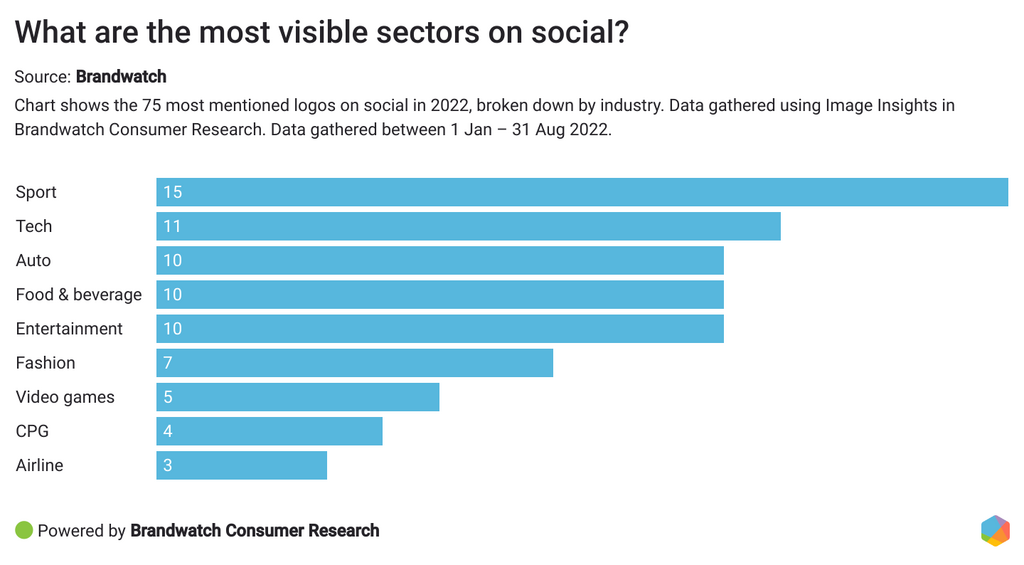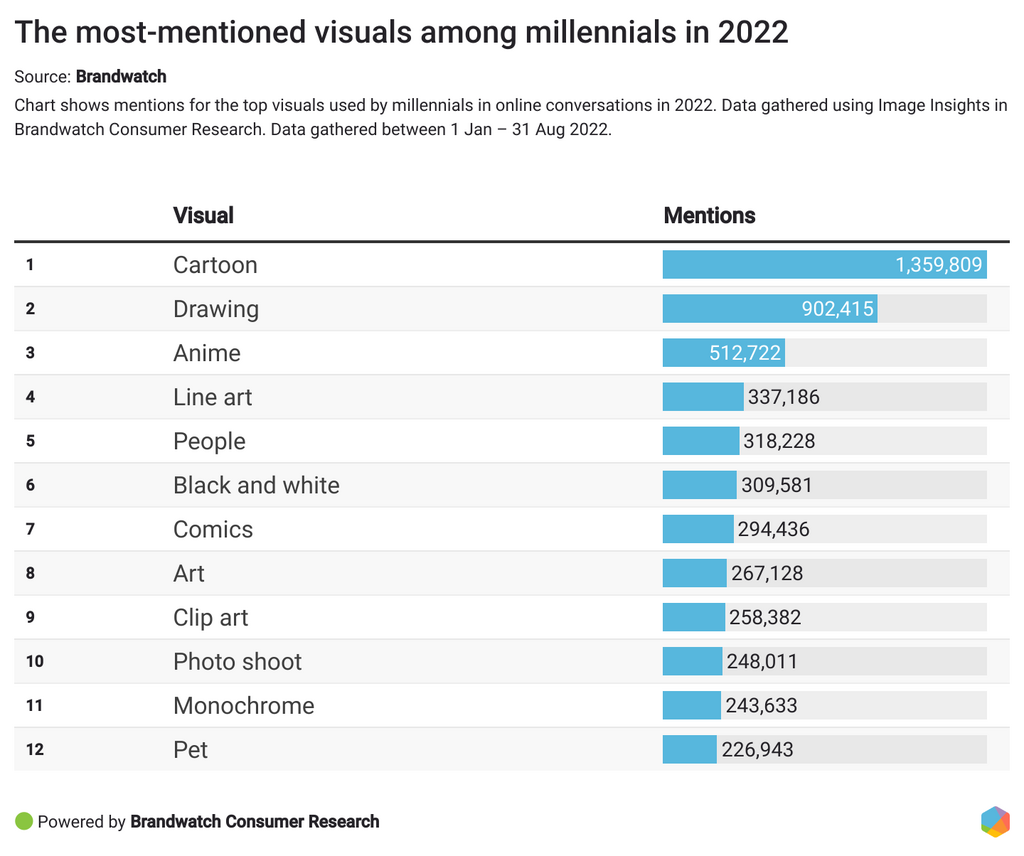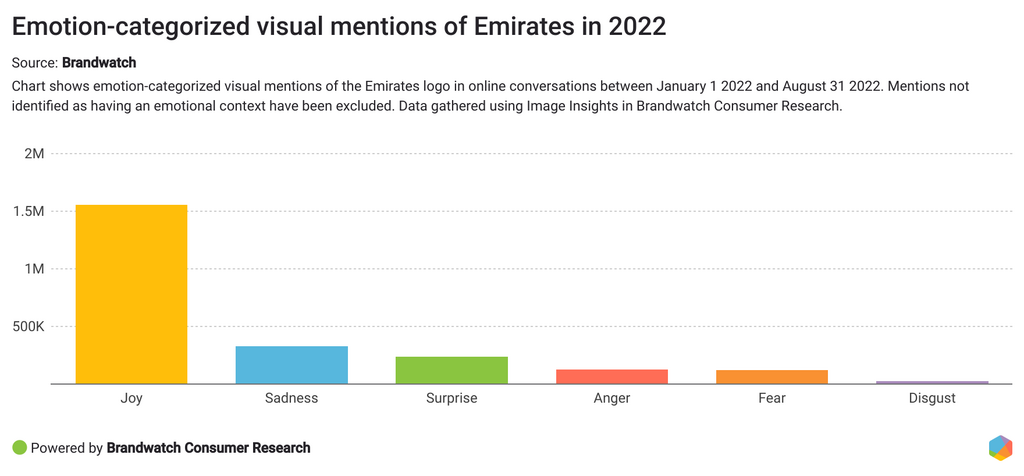REPORT
Brand Visibility Report: Why Your Brand Needs a Strong Visual Identity
Which brands are stealing the social spotlight? Here are the latest visual trends in online conversations.
Book a meetingWe analyzed millions of images posted on public social media channels to find the hottest visual trends.
We analyzed millions of images posted on public social media channels to find the hottest visual trends. Here’s what we found and how you can build your brand’s visual identity.
While tracking your brand's written mentions on social media can be easy, measuring where your brand appears visually can be difficult. These lost visual mentions tell a different story for your brand’s visibility in online conversations. By tracking these logo mentions, companies can uncover what encourages consumers to share their branding on social media.
In this report, we’ll dive deeper into what causes the most visible brands on social media to gain the traction they deserve. We look into how different generations approach visual content online and give tips on improving your brand's visual identity. Plus, we’ll share the most visible brand in 2022, and what we can learn from its success.
In this report, we’ll explore:
- The most visible industries in 2022
- Visual trends from different generations
- The most visible brands in 2022
- The effect of influencers in boosting brand visibility
- Key takeaways and how-tos
The most visible industries in 2022
Let’s look at the sectors with highly visible logos to see how much industry can influence brand visibility. To calculate this, we looked at the top 75 most visible logos in our analysis and broke them down into the sectors they belong to.
This year, the sporting industry came out on top. In second was technology, with automotive, food & beverage, and entertainment taking the remaining spots in the top five. Let’s dive into what’s trending in these industries.
Sport
With 20% of the most visible brands belonging to the sporting industry, it’s clear that this is an industry that’s hard to miss on social. From soccer teams to the NFL, people are keen to engage with photos of their favorite players and teams. Brands might benefit from sponsoring such teams to take advantage of the plethora of keen eyes glued to their go-to clubs.
Technology
The tech industry is always high on the list of most visible brands. As technology is something consumers utilize on a daily basis, brands gain visibility in an indirect way. For example, individuals sharing mirror selfies on social media will indirectly share the logo on their phones. Equally, consumers are always excited about discussing the latest tech drops with others on social.
Entertainment
While the entertainment industry only had 10 brands in the top 75 most visible logos, these 10 brands collectively contributed the most mentions overall. So, with over 31 million mentions for brands such as MTV, Marvel, and YouTube, the entertainment industry had the most mentions out of any other industry, despite having less brands in the running.
Social media is home to growing fanbases for new entertainment releases, where fans can come together to share and celebrate their favorite shows, songs, and films. With this comes sharing of visuals, including brand logos.
Visual trends from different generations
Different generations naturally have different priorities, likes, and conversations online. Diving into these mentions can help show different visual trends, in which new insights can be derived.
To do this, we used Brandwatch’s Ready to Use Socal Panels to make it easy to dive into visual trends within conversations from different generations.
To understand the data here, we split out conversations from different generations. We then used Image Insights on Brandwatch to understand the most common objects appearing within images shared in these conversations.
Gen Z (1997 to 2015)
Interestingly, Gen Z responds best to illustrations. From cartoons, which appeared in almost 4m mentions, to drawings and anime, Gen Z prefer animated content on social media. Gen Z is also used to seeing more polished content, with topics including photo shoots, portraits, and beauty.
Brands looking to reach the Gen Z audience should consider implementing more illustrations in their social content. Beauty brands are also likely to benefit from increased marketing on social media to this generation due to the high percentage of users sharing this content.
A cosmetics brand which does this successfully is Urban Decay, who use illustrations and graphic design across their social media to make their presence pop. They’ve amassed over ten million followers on Instagram, appealing to a younger fanbase who love their products.
Millennials/Gen Y (1981 to 1996)
Similar to the younger generation, millennials are also big fans of illustrations. In fact, out of the top ten most popular visuals, six were related to art. These topics include cartoons, line art, anime, and drawing. Animals begin to creep up the list, the topics of pets and animals both within the top 12 most popular topics.
Those targeting millennials would benefit from sticking with the illustration theme, and maybe adding some animals into their visuals to gain maximum exposure. The RSPCA, a UK-based animal shelter, recently gained double the number of engagements on an Instagram post when trialing an illustrated theme.
Gen X (1965 to 1980)
Gen X responds really well to faces, with the largest topic being people. Up second was animals, followed by pets. Portraits, beauty, and monochrome were also high on Gen X’s list. For this generation, it seems brands would benefit from adding a human touch to their marketing efforts. Whether this is by having photos of real people within your campaign or using videos of people using your products. You also can’t go wrong with a photo of a dog.
Baby boomers (1946 to 1964)
For baby boomers, animals were the most visible images at 8% of image-analyzed content. Pets, dogs, and cats were also common in these conversations. It seems boomers are fans of sharing their pets online and interacting with others’ animal photos. Businesses trying to appeal to this demographic might benefit from sharing more animal-related content to gain the attention of this generation.
What can we learn from generation visuals?
It seems the lines blur with the favorite visuals for each generation, as would be expected. However, humans always appeared in the top most-shared visuals on social media. Brands should incorporate real-life use cases to properly resonate with their audience – no matter which demographic you’re targeting.
Equally, utilizing illustrations and graphics is likely to work for younger audiences, to truly grasp their attention on social. Alternatively, if you’re targeting older audiences, you can’t go wrong with using animals.
The most visible brand in 2022
#1
Brandwatch's most visible brand in 2022 Emirates
Brandwatch Consumer Research identified Emirates as the frontrunner for brand visibility in 2022. Emirates’ logo was the most prominent in our database of 700+ logos, which features some of the biggest brands on the planet.
With tough competition, including Adidas, Apple, and MTV, Emirates’ recognizable branding stormed ahead with over 8 million mentions between January and August this year. So, what makes Emirates such a visible brand?
Sponsorships
Emirates is known for soccer sponsorships, and 21% of their visual mentions are sports-related. Namely, Emirates sponsors clubs like AC Milan, Arsenal FC, and Real Madrid, so the airline proudly has its logo on a handful of famous soccer teams. Emirates also sponsors the English FA Cup, an annual competition that gathers attention from across the globe. In May 2022, over 14.6 million people tuned in to the FA Cup final across the different network providers.
Emirates gathers millions of visual mentions on social media through these sport-based sponsorships. From fans posting photos from soccer games to the clubs themselves tweeting to millions of loyal followers, Emirates is gaining visibility of their logo every day.
🎂 Happy birthday @RealMattLucas
— Arsenal (@Arsenal) March 5, 2022
A comedy legend, lifelong Arsenal fan and patron of @GayGooners ✊
Have a great day, Matt 🥳 pic.twitter.com/xhgZ02koFK
The sentiment
Over 75% of Emirates’ sentiment-categorized visual mentions were positive. Emirates's logo was associated with plenty of positive press this year, from fans celebrating their favorite team winning to memes about soccer players. With their logo appearing in conjunction with such positive press, consumers are more likely to affiliate Emirates with positive sentiment.
Among the mentions categorized as joyful, some prevalent topics included sporting teams’ wins and tweets about favorite players wearing Emirate’s-sponsored jerseys. Diving deeper, there are also a number of tweets wishing family and friends happy birthday who happen to be wearing sponsored kits. Another well-received topic was customers sharing they’ve been reunited with family members after a flight or sharing their experience on the airline.
Behind joy, sadness was the second most prevalent emotion category at 14%. These mentions are mostly about sadness when teams sponsored by Emirates lost a sporting game or if a player sponsored by Emirates hasn’t played as well as expected.
What can we learn from Emirates?
The prevalence of visual mentions about Emirates related to sports shows just how beneficial their marketing efforts are. The brand awareness Emirates continues to receive for their sponsorship efforts is incredible, gaining them millions of mentions a year – without even trying.
Even though Emirates is an airline, its marketing efforts mean the brand is becoming even more than its product. The company is gaining huge amounts of positive, secondhand awareness through sponsoring well-known soccer teams.
Other brands we admire for their strong visual identity
Below we dive into some other brands that are seeing huge successes with their visual identity.
MTV
MTV received almost 3 million visual logo mentions between January and August this year. MTV’s visuals show up across social media, making it one of the most-mentioned entertainment brands for visual identity.
The 2022 #VMAs was the number one topic among MTV’s visuals. The VMAs, or Video Music Awards, are an annual event held by MTV to honor the best in the video music sphere.
So, why does this event help MTV’s online presence so well? Firstly, the VMAs have created a huge space on social media for fans to discuss their favorite artists and share their achievements. Fans want to see their favorite bands and solo artists getting recognition for their work, so they want to discuss this with their fellow fanbase. Secondly, MTV discreetly (and cleverly) inserted its logo into the VMA’s logo, so it’s still recognizable. By doing this, MTV gained millions of visual mentions without a direct conversation about the brand.
We are so excited to be nominated for "Group of the Year" and "Song of Summer" with "Left and Right (feat. Jung Kook of BTS)" at the 2022 #VMAs! Thank you so much for your love and support as always!💜 #BTS #방탄소년단 pic.twitter.com/akU7iklTl2
— BTS_official (@bts_bighit) August 20, 2022
Brands can learn from MTV by creating a strong visual identity – and sticking to it. Utilize your logo in all aspects of your social media strategy to gain secondhand visibility across various platforms. Every marketing campaign should include your branding among the visuals.
Chanel
Chanel is one of the most visible luxury fashion brands on social media at the moment. The brand’s strong visual identity means its logo pops up all over the place, from fans sharing their favorite handbag to consumers sharing wishlists for wanted items.
Chanel gathered well over 200k visual mentions in the first half of 2022, with 68% of emotion-categorized mentions being joyful. This conversation includes Chanel’s work with influencers, where tweets from influencers’ fans are some of the mentions with the most reach. By styling stars with their product, even subtly, Chanel placed their brand directly in front of a whole new audience.
Proud of u chae 💖
— Rem | 🎲 🍭 (@Rem_nayunnie) August 2, 2022
CHAEYOUNG x CHANEL#CHAEYOUNGatChanel #채영 #CHAEYOUNG @JYPETWICE pic.twitter.com/1fJXySbuN5
Puma
Puma has received well over 4m visual brand mentions so far in 2022, putting them high on the list of visible fashion brands. So, how did the sportswear brand do it? Similar to Emirates, Puma is a frequent sponsor of sports teams and celebrities. This makes up a large portion of the brand’s visual mentions, with arenas and stadiums being in the top 5 topics associated with Puma’s visual mentions.
Puma also received an impressive number of consumers sharing their brand logo by accident. Whether they’re in front of a bus with the Puma logo on or sharing their outfit for the day, Puma’s strong visual identity receives secondhand shares on social.
ICYMI @QLDmaroons WON STATE OF ORIGIN!!!!!!!!! pic.twitter.com/f4VnzVkZ99
— Katie Brown 🤸🏼♀️ (@katiebrownaus) July 13, 2022
Brands can benefit from following in Puma’s footsteps by taking steps to eventually become a household name. If consumers are used to seeing your brand in day-to-day interactions, they’ll notice your visual identity when interacting with content on social media. Equally, by sponsoring relevant events or celebrities with positive sentiment online, brands can gain indirect positive exposure of their logo.
Let’s dive deeper into how influencers can strengthen visibility on social.
The effect of influencers in boosting brand visibility
The prevalence of influencers for brand visibility is growing. From one-off campaigns to full-blown marketing ads, influencer marketing is here to stay – and for good reason. Most brands who work with influencers are doing so to attract a new audience or get closer to a given influencer's audience. And as these stars have developed a close relationship with their audience, followers trust their recommendations, meaning brands can see great ROI if the campaign is done right.
We analyzed the use of the hashtags #ad and #sponsored, common in sponsored posts with influencers. We found over 15m mentions in the visual brand conversation – that’s the same as the number of Ubers taken every day. One of the largest subtopics was giveaways, with over 5m mentions having ‘giveaway’ in the influencer’s post. Perhaps this indicates an easy, yet successful, way for any brand to utilize an influencer’s audience to show off their product.
When categorizing these posts by emotion, an impressive 88% of mentions were joyful. Social media stars portray positive sentiment towards the brands they work with, and their audience is also happy about the collaboration.
From giveaways to sponsored posts, influencers can be utilized to tap into a widely positive conversation – and they’re perfect if you’re looking to boost your brand’s visibility online.
Key takeaways for brands building a strong visual identity: How to improve your branding
Here are ways for your brand to build visibility on social media.
Create a strong brand identity
As with MTV and the VMAs, or with Emirates and its sport sponsorships, it all starts with a strong brand identity. Without clear brand guidelines, a recognizable logo, and relevant visuals, you’re less likely to reap the benefits of social media sharing for your brand. Before looking into expanding your marketing efforts, make sure you have strong visual assets to utilize to your advantage.
This goes for businesses of all sizes. Whether you’re a small business looking to grow locally, or a conglomerate expanding into new markets, your brand identity is a necessary first step. According to Forbes, small businesses often neglect to define proper brand guidelines, which “neglects to give potential customers a strong first impression.” Forging a strong brand identity in the early stages of your business could be the defining factor for growth.
So, how do you develop a visual identity for your brand? Here are some steps to follow when solidifying your brand identity.
Utilize sponsorships
It can be hard to measure the exact ROI on brand sponsorships. From sponsoring events to people, understanding how these campaigns are received can be a challenge. However, the most visible brands have something in common – they utilize sponsorships.
By finding relevant events and campaigns for you to place your logo onto, brands are sure to receive an unrivaled number of secondhand visual mentions. Sponsorships are also excellent for introducing your brand to new fanbases and audiences.
Sponsorships don’t have to be for huge events either. Begin by looking locally. Are there any relevant events nearby that might benefit from your sponsorship? From high school sporting events to local craft fairs, getting your name out via these events can prove just as useful as sponsoring large soccer games. They all serve the same purpose: to reach a larger audience than you would gain without this advertisement. And by taking inspiration from big names like Emirates and Puma, we can see what works.
Plus, it's clear that using social listening tools, like Brandwatch, can make tracking the ROI of these campaigns much easier.
Maximize influencer marketing
The influencer marketing industry is set to grow to approximately $16.4 billion in 2022. Brands not utilizing influencers in their marketing strategy in today’s day and age risk getting lost behind, and this is still true for visual branding.
From dressing influencers in your clothing to working with them on specific campaigns, brands will likely benefit from reaching a wider audience with their visual identity through influencer marketing. Plus, these influencers carry an impressive amount of positivity for their audience, which brands can maximize.
Brands don’t need to work with big names either. Micro-influencers are just as beneficial for brands with a smaller budget or who want to reach a more specific demographic. Micro-influencers offer a closer relationship with their followers and often have a higher engagement rate – giving brands better visibility to a target audience.


